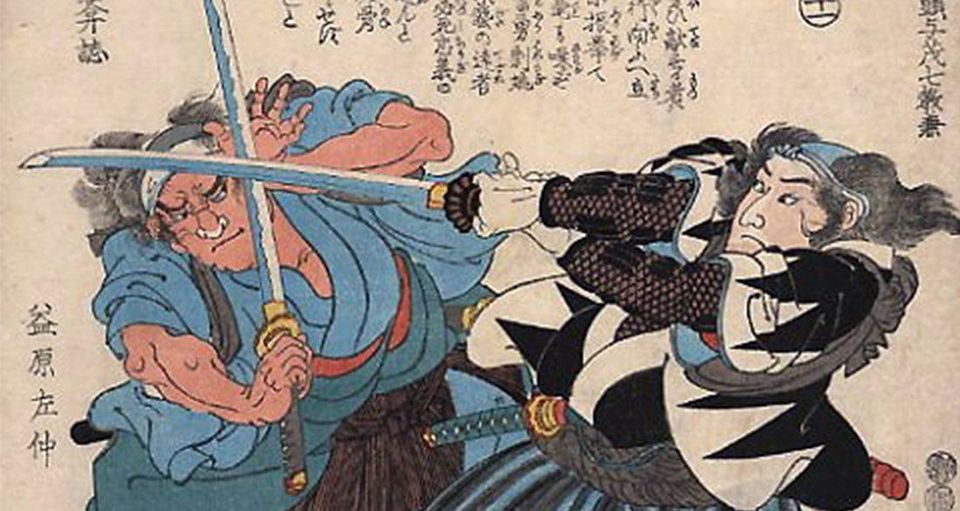VOICE and The Book of Five Rings - Innovation

This is the third post in a series on the VOICE principles and the philosophy of Miyamoto Musashi as written in The Book of Five Rings. The translation of The Book of Five Rings used here was sourced from WikiQuote.
I wrote this series while working at YP.com. I’ve updated some of the language to reflect the past tense and generally make it read easier.
You can start from the beginning of the series here.
We at YP.com practiced the VOICE principles (Velocity, Ownership, Innovation, Collaboration, and Execution), striving to embody each of them in order to become more effective at not only our jobs, but in our personal lives.
In the 16th century, a Japanese Ronin (a lord-less samurai) named Miyamoto Musashi wrote The Book of Five Rings. In it Musashi describes his philosophy, called “The Way” of sword fighting, which is still studied today and can be applied across any discipline.
This series explains how the sword fighting principles of The Way can be generalized to each VOICE principle, leading you to becoming more productive in your life. In the previous entry, I wrote about how Musashi’s teachings relate to Ownership. In today’s post, I’ll be covering Innovation.
Innovation
Use of the word “innovation” has increased dramatically over the past 65 years, and for good reason. The definition of innovation, per Merriam-Webster, is “the introduction of something new” or “a new idea, method, or device.” Given the rapid pace of change in this time frame alone, it’s understandable why the term has increased in popularity, particularly in the fields of technology and organizational development.
Innovation is something we strive for both as an organization, as well as individually. As an organization, we work to be innovative in our field, whether by creating new products, customer service processes, or sales techniques. Individually, we innovate by trying a new time management system, starting our own cryptocurrency, or learning a new language. Only by staying innovative at both the micro and macro levels can we hope to not only stay relevant but earn greater successes.
Develop intuitive judgment and understanding for everything.
At its core, to be truly innovative, you must have complete understanding and the ability to accurately perceive situations. Understanding of everything doesn’t only mean an understanding of the “thing” that you are trying to innovate, but an understanding of many things, including those unrelated. The common phrase of “thinking outside of the box”, or peripheral knowledge, refers to the ability of one to apply seemingly unrelated principles or theories to a given problem.
Developing intuitive judgment is similarly necessary, as an understanding of everything must be filtered to eliminate irrelevant information. A product manager has to judge whether a feature in a dating app will translate and still be intuitive to a YP for Business user, and a Sales trainer needs to decide how to apply the Unix philosophy to their curriculum and methodology. The combination of understanding of everything and the propensity for intuitive judgment is invaluable when attempting to innovate in any area.
When the fight comes, always endeavor to chase the enemy around to your left side. Chase him towards awkward places, and try to keep him with his back to awkward places. When the enemy gets into an inconvenient position, do not let him look around, but conscientiously chase him around and pin him down. In houses, chase the enemy into the thresholds, lintels, doors, verandas, pillars, and so on, again not letting him see his situation.
And
Always chase the enemy into bad footholds, obstacles at the side, and so on, using the virtues of the place to establish predominant positions from which to fight.
What the heck does chasing someone around with a sword have to do with innovation? Nothing! It’s a metaphor for pursuing your enemy (the problem or task) into awkward and unusual circumstances, forcing yourself to examine them from diverse perspectives and attack them in uncommon ways.
Innovation requires us to not only pursue a challenge unrelentingly, but to do so in unconventional ways. We can’t always use a cookie cutter to solve problems; they often require creative problem solving, or more specifically red teaming. Take a big step back, throw out all of your preconceived assumptions, and re-evaluate how to best tackle the challenge.
"To release four hands" is used when you and the enemy are contending with the same spirit, and the issue cannot be decided. Abandon this spirit and win through an alternative resource.
In large-scale strategy, when there is a "four hands" spirit, do not give up - it is man's existence. Immediately throw away this spirit and win with a technique the enemy does not expect.
And
"To renew" applies when we are fighting with the enemy, and an entangled spirit arises where there is no possible resolution. We must abandon our efforts, think of the situation in a fresh spirit then win in the new rhythm. To renew, when we are deadlocked with the enemy, means that without changing our circumstance we change our spirit and win through a different technique.
These strategies are similar, and can be interpreted in several ways. One is that we (YP and other companies in the local space) are competing with one another in equal ways and with equal vigor, and we (YP) must abandon this head-on battle and fight via other methods to succeed. Another is that we cannot win by duplicating the features of others, whether they’re products, processes, or methods, but we must creatively solve these for ourselves. A third is that, to simply fight with an opponent in the space, using the same methods, will not decide the battle. Innovation is required to disrupt the status quo, and become more than we are now, more than just the sum of our parts.
Many things can cause a loss of balance. One cause is danger, another is hardship, and another is surprise. You must research this.
In large-scale strategy it is important to cause loss of balance. Attack without warning where the enemy is not expecting it, and while his spirit is undecided follow up your advantage and, having the lead, defeat him.
Innovation in an area causes a loss of balance. It puts competitors off balance (in a bad way, for them) and it puts customers off balance (in a good way, for them). Danger, hardship, and surprise can cause one to lose stability, all of which are inevitable situations one will face without change and innovation driving us forward.
Stagnation is also a loss of balance, but in the opposite direction. Disruptive change is necessary to prevent that stagnation. But too much disruption can also cause one to lose balance, not allowing a foothold to be gained.
To defeat one’s “enemy”, whether it be a competitor in the market, a challenge to solve, or a conflict with another person, one must maintain ones balance, while working to throw off the balance of the other. Correspondingly, to simply innovate isn’t enough. It’s equally important to follow through with the advantage provided by that innovation, as others will be quick to duplicate it.
In this world it is said, "One inch gives the hand advantage", but these are the idle words of one who does not know strategy… From olden times it has been said: "Great and small go together."… In my doctrine, I dislike preconceived, narrow spirit.
Here Musashi is saying to throw out all preconceived notions and assumptions. All options are available and should be used. To narrow ones viewpoint is to limit ones options, therefore limiting ones possibility of success.
In order to innovate, we have to throw out the traditions, conventions, and rules. We must work without rules to create something new, something better. Iteration is not innovation, and assumptions of what has worked in the past can’t be used when strategizing for the future.
To innovate, we must free our minds of the boundaries we unconsciously raise within them to make our lives easier.
Conclusion
Innovation is key to strategy in battle and in business. I’ve set out how Musashi’s Way teaches that innovation comes through the understanding of everything, intuitive judgment, freeing yourself of preconceptions, maintaining balance, and creative thinking.
While we can’t expect to wake up tomorrow and decide to innovate, we can set the foundation required for innovation by applying The Way to our thinking. Begin by studying what may appear to be peripheral or unrelated subjects, and examine how your own biases and assumptions may prevent you from hearing or accepting alternative ideas. Lastly, apply the rules of Red Teaming by having someone without prejudice look at it from the outside.
Next in the series we’ll read what Miyamoto Musashi writes about collaboration.




